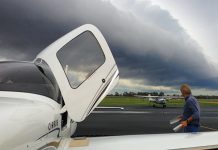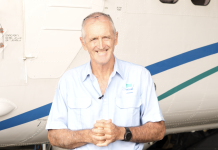You may not live long enough to enjoy the money you save by deferring aircraft maintenance.
US Air Force F-16s caught up to the private jet about 20 minutes after it had violated the secure airspace of Washington, DC.
In the bright clear air at 34,000 feet, the fighter pilots saw a slumped figure in the left seat as the Cessna Citation 560 flew steadily on, following the heading of the runway that had been its destination earlier that day. The fighter pilots tried radio calls and flares but received no response from the ghostly aircraft.
After 2 minutes, steady flight turned into a spiral dive that became vertical. All 4 people on the Cessna were probably already dead before the impact. The crash, with its unresponsive flight crew and steady automatic flight until fuel exhaustion, had all the hallmarks of hypoxia.
An hour earlier, the pilot had stopped responding to air traffic control instructions as the aircraft climbed through 26,000 feet. ADS-B data showed the aeroplane climbing to 34,000 feet and turning southwest to overfly its intended destination in Long Island about one hour later.
A National Transportation Safety Board (NTSB) report published in May 2025 concluded the Cessna’s pressurisation system had failed, bringing unconsciousness then death to the occupants. The pilot’s 25,000 hours had been of no help in detecting the slow onset of hypoxia. The worst discovery was that this need not have happened.
The NTSB found 5 maintenance items were overdue on the date of the accident, 4 June 2023, including an inspection of the copilot’s oxygen mask.
On 11 May in that year, maintenance personnel had performed a walkaround inspection of the aircraft and noted 26 issues, including several related to the pressurisation and environmental control system. They pointed these out to the pilot, who contacted the aircraft owner. The owner, who had recently bought the aircraft, declined to address the items. The owner told the maintainers the aircraft still had a ‘warranty’ from the seller, so the plan would be for the seller to address the issues.
When the NTSB report was published, its former chairman Robert L Sumwalt expressed astonishment and dismay on social media. ‘Why would someone who owns an airplane, or the pilot who flies that aircraft, refuse to have so many maintenance items repaired?’ he wrote. ‘It’s always amazed me that people will spend millions of dollars to buy an airplane but then try to operate it as cheaply as possible. It simply doesn’t make sense. And it’s an attitude that can be deadly.’
Staying informed, staying alive
Sometimes the missing factor in maintenance is not money but information.
On 22 November 2022, a Robinson R44 crashed in Charlotte, North Carolina, killing the pilot and a TV weather presenter. The NTSB found connecting hardware was missing from a control rod end that attached to the helicopter’s stationary swashplate. ‘It is unlikely that the hardware was secure before the flight and may have been loose for multiple flights before the accident,’ the accident report said.
A field overhaul of the helicopter in August 2019 included the replacement of 3 rod ends, including the forward left control rod end that was implicated in the accident. The NTSB noted that a Robinson Helicopter Company service letter had not been complied with in this overhaul.
The letter instructed operators to replace cadmium-plated nuts with D210-series nuts due to corrosion and cracking issues. The overhaul kit included a set of replacement D210 nuts but when the NTSB investigated the wreckage, it found a mix of old style and D-210 nuts throughout the flight controls. ‘The type of nut that liberated from the forward left control rod/stationary swashplate could not be determined.’
After all these years
The Cessna 172 had led a quiet existence for the past 7 years: 31.5 hours in the air over that time, although flight details were not recorded. The figure came from the difference between its hours on July 2008, the date of its last annual inspection, and the total hours NTSB inspectors found when they inspected it as a wreck, on 25 January 2017.
The owner had filled the wing tanks from fuel cans and taxied several times along a private airstrip in Jay, Oklahoma. When the aircraft did not arrive at the nearby Grove Airport, a search took place. The aeroplane was found crashed in a field not far from the airstrip, with the pilot dead.
The fuel tank selector was set on the right tank, but when the NTSB team blew pressurised air through the fuel system, it emerged in the left tank, which was effectively empty, with only 2 US gallons of unusable fuel. A pin in the fuel tank selector had failed and, even though the pilot had selected the fullest tank, that selection had not been made. Fuel starvation had followed promptly.
The NTSB report concluded, ‘The lack of routine maintenance on the airplane likely eliminated the necessary opportunities for the missing securing pin to be corrected.’
Paying the price
Each of these sad stories has a clear theme: responsibility for keeping your aircraft airworthy is down to you as the registered operator. It doesn’t matter who pays or how little the aircraft has flown – the only important thing is that the work is done and, as the registered operator, you must make sure it’s done.
CASA Advisory Circular 1-04 – Registered operator responsibilities for continuing airworthiness makes an aircraft registered operator’s responsibilities clear:
Registered Operators (RO) are required to ensure that aircraft being used in their operations are maintained in accordance with the applicable sections of Parts 4A to 4D of the Civil Aviation Regulations 1988 (CAR) and they are in a condition for safe operations.
It is a registered operator’s responsibility to ensure airworthiness directives, advisory circulars and service letters are complied with. Manufacturers and regulators send these directly to the registered operator and they are available online for most aircraft types. In the real world, this is a responsibility often shared with maintenance organisations that have daily familiarity with the issues affecting aircraft types, but the law is clear: your aircraft, your problem.
The law is clear: your aircraft, your problem.
Say something
CASA Principal Airworthiness Engineer Gus Anderson says the regulator too often discovers instances of aircraft defects being ignored.
‘Investigations carried out by CASA often reveal pilots carrying aircraft defects while on deployment away from their main base, with defects not being entered on the maintenance release when they arise,’ he says. ‘All unserviceable equipment must be covered either by an approved company minimum equipment list (MEL), the configuration deviation list (CDL) from the flight manual or a CASR-approved permissible unserviceability (PU) under CASR 21.007. Operating the aircraft outside of these parameters removes the aircraft from its type design.
Commercial pilots who find themselves being pressured into flying aircraft with an unreasonable number of deferred or ignored maintenance items have the option of anonymous reporting through schemes run by either CASA or the ATSB.
CASA safety reporting
Report safety concerns about aviation safety to CASA.
REPCON
REPCON is the ATSB’s voluntary, confidential reporting scheme for safety concerns. It is not an alternative to mandatory reporting.





